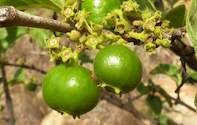Wild medlar (Vangueria infausta) has various common names: wildemispel, Mmilo, Muzwilu, Mavelo, Umviyo, Mpfilwa, Umtulwa, Mothwanye, Umvile and Amantulwane.

Wild medlar is a multi-stemmed fruit tree between 3 and 7 m high with velvety green leaves. It is found on rocky ridges, hillsides, grassland and on sand dunes near the coast in the Eastern Cape, Free State, KwaZulu-Natal, Mpumalanga, Gauteng, Limpopo, North West and Northern Cape provinces as well as other countries in southern Africa.
The indigenous fruit tree is believed to possess evil powers; it could cause cattle to bear only bull calves so the wood is not even used for fires. In contrast, the fruit is very popular (it tastes like apple) and is high in vitamin C.
Wild medlar fruit starts green, but ripens to a dull orange-purplish colour from January to April. Harvesting can be done from late October to early November when fruit is not fully ripe. Alternative fruit can ripen on the tree until autumn to develop flavour, if there is no danger of frosts. Fruit is round and glossy and about 3.5 cm in diameter.
It has a dry, floury flesh with a sweet-sour taste and has high levels of calcium (Ca) and potassium (K). Wild medlar is used as a pulp in desserts and for making wine. The dried fruit can be stored for times of food scarcity, but additives and a lightly fermented porridge can be produced from them. In Botswana wild medlar is processed into a juice high in vitamin C.
Wild medlar roots have traditionally long been used for treating malaria and pneumonia. In addition, an infusion of the roots and leaves can treat ringworms, menstrual and uterine problems as well as toothache.
A decoction of the pounded leaves and small twigs helps heal swollen limbs in children. Wild medlar is a slow grower, but well-adapted to desert and semi-desert areas in temperatures ranging from 17 - 28℃.
It is not easy to grow wild medlar from seeds, but sowing the seeds in November has a better germination rate than sowing it in June. Soak the seeds before planting. The best way to propagate wild medlar is by planting cuttings.
Medical Disclaimer
Information is for educational and informational purposes only and may not be construed as medical advice. The information is not intended to replace medical advice or treatment offered by healthcare professionals.By Marinda Louw